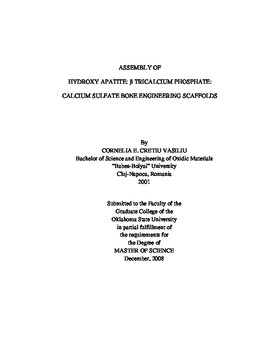| dc.contributor.advisor | Smay, James E. | |
| dc.contributor.author | Cretiu Vasiliu, Cornelia E. | |
| dc.date.accessioned | 2014-04-16T03:07:13Z | |
| dc.date.available | 2014-04-16T03:07:13Z | |
| dc.date.issued | 2008-12-01 | |
| dc.identifier.uri | https://hdl.handle.net/11244/9626 | |
| dc.description.abstract | Directed assembly and characterization of composite Hydroxyapatite/BetaTri-CalciumPhosphate/Calcium Sulfate (HA/TCP/CaS) scaffolds with designed pore distribution for controlled solubility. Concentrated aqueous colloidal gel ink for extrusion-based direct writing was formulated with commercial HA and TCP powders blended with, ammonium poly(acrylate) (dispersant), hydroxypropylmethylcellulose (viscosifier), and Polyethyleneimine (flocculant). Prior to ink formulation, HA and TCP powders were calcined, milled, dried and characterized by X-ray diffraction. Mixtures of HA:TCP in volumetric ratios of 15:85, 35:65, and 60:40 were formulated as inks. Rice starch was formulated as ink and mixtures ceramic: rice starch blended in volumetric ratios of 85:15, 75:25, and 50:50 were produced. Disk samples (diam.11mm and 3mm thick) with an internal lattice structure of 250 micrometers rods spaced by 250 micrometers or 500 micrometers in a periodic, open pore network were printed and sintered at 1100, 1125, 1150, 1175, and 1200oC for 4 hours. The control set for each composition and pore structure had empty pores while the two test groups were filled with 2.4% Chitosan gel or Calcium Sulfate (CaS). The scaffolds were immersed in simulated body fluid and weight loss was measured by gravimetric analysis on a three day frequency. The assembled three-dimensional, binary HA/TCP structures can be sintered successfully and have both phases present in the final product. The scaffolds dissolve faster with higher TCP content and CaS filled scaffolds show dissolution behavior dominated by surface erosion of the filler phase. Micro-porosity induced by porogens does not accelerate the dissolution in vitro. In contrast, chitosan filled samples showed minimal weight loss, attributed to shielding of the TCP from SBF by the conformal and relatively stable chitosan hydrogel. Designer porous HA-TCP scaffolds may also include controlled solubility behavior by controlling HA:TCP ratio and selecting soluble pore filler. CaS may be used as a sacrificial pore filler to retard scaffold dissolution by 75 days, whereas chitosan hydrogel may persist as filler for longer periods. | |
| dc.format | application/pdf | |
| dc.language | en_US | |
| dc.publisher | Oklahoma State University | |
| dc.rights | Copyright is held by the author who has granted the Oklahoma State University Library the non-exclusive right to share this material in its institutional repository. Contact Digital Library Services at lib-dls@okstate.edu or 405-744-9161 for the permission policy on the use, reproduction or distribution of this material. | |
| dc.title | Assembly of Hydroxy Apatite: ? Tricalcium Phosphate: Calcium Sulfate Bone Engineering Scaffolds | |
| dc.type | text | |
| dc.contributor.committeeMember | Gasem, Khaled A.M. | |
| dc.contributor.committeeMember | High, Marty | |
| osu.filename | CretiuVasiliu_okstate_0664M_10066.pdf | |
| osu.college | Engineering, Architecture, and Technology | |
| osu.accesstype | Open Access | |
| dc.description.department | School of Chemical Engineering | |
| dc.type.genre | Thesis | |
